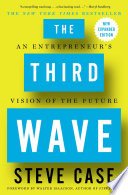

In 'The Third Wave', Steve Case outlines the evolution of the internet through three distinct waves. The first wave was characterized by the creation of the internet itself, establishing the foundational infrastructure that allowed for digital communication. This wave saw the emergence of internet service providers and the development of web browsers, which made the internet accessible to the general public. The second wave was marked by the rise of social media, e-commerce, and mobile applications, transforming how users interacted with the internet and each other. The third wave, according to Case, is about integrating the internet into everyday life, where technology becomes invisible and embedded in various sectors such as healthcare, education, and transportation. This wave emphasizes the importance of collaboration between startups, established companies, and government entities to create a seamless digital experience that enhances daily living.
Continue readingCase emphasizes the pivotal role entrepreneurs play in driving innovation and shaping the future of the internet. In the third wave, entrepreneurs are seen as key players who can leverage new technologies to solve real-world problems. They are encouraged to think beyond traditional business models and consider how their innovations can integrate with existing industries. Case argues that successful entrepreneurs will focus on building partnerships with established companies and government agencies to navigate regulatory challenges and scale their solutions effectively. By fostering a collaborative ecosystem, entrepreneurs can create impactful products and services that address the needs of society while driving economic growth.
Continue readingCollaboration is a central theme in 'The Third Wave'. Case stresses that the future of the internet will not be shaped by isolated entities but through cooperative efforts among various stakeholders. This includes partnerships between startups and large corporations, as well as collaborations with government agencies to create policies that support innovation. Case provides examples of successful collaborations that have led to significant advancements in technology and business. He argues that fostering a culture of collaboration will be essential for navigating the complexities of the third wave, as it requires a collective effort to address societal challenges and leverage opportunities presented by emerging technologies.
Continue readingAs we move into the third wave, technology is increasingly becoming an integral part of our daily lives. Case discusses how advancements in the Internet of Things (IoT), artificial intelligence, and other technologies are transforming various sectors, including healthcare, education, and transportation. He highlights the potential for these technologies to improve efficiency, accessibility, and quality of life. However, Case also warns of the challenges that come with this integration, such as privacy concerns and the need for ethical considerations in technology development. He advocates for a balanced approach that prioritizes user experience and societal impact while harnessing the power of technology.
Continue readingIn 'The Third Wave', Case addresses the significant role that government and policy play in shaping the future of the internet. He argues that effective policies are crucial for fostering innovation and ensuring that the benefits of technology are shared widely. Case emphasizes the need for governments to adapt to the rapidly changing technological landscape by creating regulations that support entrepreneurship and protect consumers. He also discusses the importance of public-private partnerships in addressing societal challenges, such as healthcare and education, and how these collaborations can lead to innovative solutions that benefit the community as a whole.
Continue readingCase explores how the third wave of the internet will impact the future of work. With the rise of remote work, automation, and AI, the traditional workplace is undergoing significant transformation. He discusses the need for workers to adapt to new skills and roles that will emerge in this evolving landscape. Case emphasizes the importance of lifelong learning and continuous skill development to remain competitive in the job market. He also highlights the potential for technology to create new job opportunities and improve work-life balance, suggesting that the future of work will be more flexible and integrated with technology than ever before.
Continue readingFinally, Case underscores the importance of the human element in technology development. He argues that while technology can drive innovation and efficiency, it is ultimately people who determine its success and impact. Case encourages entrepreneurs and technologists to prioritize user experience and societal needs in their designs. He believes that technology should enhance human connection and improve quality of life, rather than detracting from it. By focusing on the human aspect of technology, innovators can create solutions that resonate with users and foster a more inclusive and equitable digital future.
Continue reading